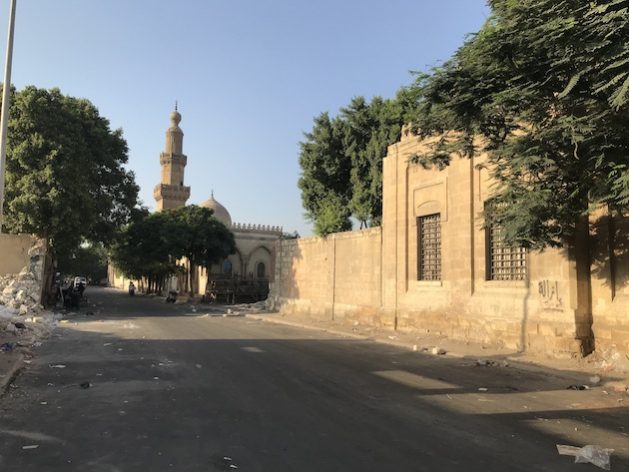Egypt Sacrifices Part of UNESCO Site for Road Development

CAIRO, Oct 18 (IPS) - The Egyptian government is clearing a vast area in Historic Cairo, a UNESCO World Heritage Site, to make way for new main roads and flyover bridges, which it says will improve traffic flow in the sprawling, congested megacity.
The developments are being pitched as part of an effort to modernize Egypt and connect the heart of the capital with a new administrative one being built 45km (28 miles) to the east.
However, the affected gravesites are mostly from the past century and include some in the famous City of the Dead, where Egypt’s notables have long been buried, often in fancy marble tombs engraved with Arabic calligraphy.
The city’s two main cemeteries radiate north and south from a central citadel known as the City of the Dead. Building the new highway will entail removing thousands of family graves, including those of historic figures from Egyptian history and culture.
Dr Islam Assem, an assistant professor of modern and contemporary history, told IPS that the demolition of these historic cemeteries is a "disaster by any measure." He said that there is no rational justification for the demolition and that it is a decision that was not made after any study.
"Under any circumstances, we cannot destroy our heritage with our own hands and erase our identity and history," Assem said.
He cited the example of Egypt's construction of the Aswan High Dam, where it was discovered that the reservoir would cover archaeological sites behind the dam. Egypt worked with UNESCO to save the Abu Simbel Temple and other antiquities that were threatened by flooding.
"The government should have taken its time and found logical solutions for these cemeteries, such as moving them in a respectful way," Assem said.
He added that the cemeteries "carry a history of at least 250 years that is not written in books but is written on the tombstones of these places."
Heritage enthusiasts are collecting tombstones, plaques, inscriptions, and unique mausoleums from 17 cemeteries being demolished by the government in Historic Cairo. They are afraid that these items will be stolen or destroyed. The tombs of Ali Pasha Fahmi and the Daramli family, as well as the tomb of the freedmen of Prince Ibrahim Helmy, which was built over a century ago, are being demolished.
Historian Sameh Al-Zahar said that Historic Cairo is entirely listed on the UNESCO World Heritage List, including the cemeteries, which is the area where development and demolition work is taking place. This is regardless of whether some of the cemeteries are registered or not.
Al-Zahar, a specialist in Islamic antiquities, added that the officials' comment that the demolition is taking place on unregistered cemeteries is "a true statement with a false intention." The meaning of the government not registering them is that this denies their significance, as some employees believe that we have enough antiquities and, therefore, there is no need to register them.
Some of these cemeteries date back historically between 700 and 1,000 years. Al-Zahar explained that this land was allocated by Omar ibn al-Khattab, the second caliph of the Muslims, to be a city for the dead for Egyptians for 1,400 years.
He continued that eviction operations are taking place without legal, moral, or humanitarian justification, as the owners of these cemeteries own them with official contracts. Therefore, no one has the right to expropriate their property and transfer their remains without their consent and the consent of their families.
According to Al-Zahar, the government is using double standards by registering some places as archaeological buildings, such as the late President Gamal Abdel Nasser's home and the Rifa'i Mosque, even though they are less than 100 years old, simply because they are associated with historical and important figures. He stated that the government demolished the graves of al-Maqrizi and Ibn Khaldun in Sufi cemeteries in the 1990s, so the demolition strategy of historic cemeteries is not new.
IPS UN Bureau Report
Follow @IPSNewsUNBureau
Follow IPS News UN Bureau on Instagram
© Inter Press Service (2023) — All Rights Reserved. Original source: Inter Press Service
Where next?
Browse related news topics:
- Trade, Economy, & Related Issues
- Causes of Poverty
- Third World Debt Undermines Development
- Geopolitics
- Conflicts in Africa
- Middle East
- Environmental Issues
- Biodiversity
- Nature and Animal Conservation
- Climate Change and Global Warming
- Consumption and Consumerism
- Sustainable Development
- G8: Too Much Power?
- Food and Agriculture Issues
Read the latest news stories:
- Make America Great Again? Not by This Administration Wednesday, April 02, 2025
- Hunger and Heightened Insecurity Pushes Sudan to the Brink of Collapse Wednesday, April 02, 2025
- Regime Obstructs Aid, Orders Air Strikes in Quake-hit Myanmar Wednesday, April 02, 2025
- Collapse of Gaza Ceasefire and its Devastating Impact on Women and Girls Wednesday, April 02, 2025
- UN condemns killing of 1,000 people in Gaza since ceasefire collapse Wednesday, April 02, 2025
- World is ‘failing’ people with disabilities: UN deputy chief Wednesday, April 02, 2025
- Sudan: Sexual violence used as weapon of terror against women and girls Wednesday, April 02, 2025
- Myanmar quake: UN calls for urgent protection for vulnerable women and girls Wednesday, April 02, 2025
- ‘Attacks on aid workers must end,’ Security Council told Wednesday, April 02, 2025
- Accountability for missing persons is ‘crucial’: UN human rights chief Wednesday, April 02, 2025
Learn more about the related issues:
- Trade, Economy, & Related Issues
- Causes of Poverty
- Third World Debt Undermines Development
- Geopolitics
- Conflicts in Africa
- Middle East
- Environmental Issues
- Biodiversity
- Nature and Animal Conservation
- Climate Change and Global Warming
- Consumption and Consumerism
- Sustainable Development
- G8: Too Much Power?
- Food and Agriculture Issues